N-Type Nanosheet FETs without Ground Plane Region for Process Simplification
Abstract
:1. Introduction
2. Materials and Method
3. Results and Discussion
4. Conclusions
Author Contributions
Funding
Data Availability Statement
Conflicts of Interest
References
- Chang, L.; Choi, Y.-K.; Ha, D.; Ranade, P.; Xiong, S.; Bokor, J.; Hu, C.; King, T.-J. Extremely scaled silicon nano-CMOS device. Proc. IEEE 2003, 91, 1860–1873. [Google Scholar] [CrossRef] [Green Version]
- Razavieh, A.; Zeitzoff, P.; Nowak, E.J. Challenges and Limitations of CMOS Scaling for FinFET and beyond Architectures. IEEE Trans. Nanotechnol. 2019, 18, 999–1004. [Google Scholar] [CrossRef]
- Hisamoto, D.; Lee, W.; Kedzierski, J.; Takeuchi, H.; Asano, K.; Kuo, C.; Anderson, E.; King, T.J.; Bokor, J.; Hu, C. FinFET—A self-aligned double-gate MOSFET scalable to 20 nm. IEEE Trans. Electron Devices 2000, 12, 2320–2325. [Google Scholar]
- Lee, S.Y.; Kim, S.M.; Yoon, E.J.; Oh, C.W.; Chung, I.; Park, D.; Kim, K. A novel multi-bridge-channel MOSFET (MBCFET): Fabrication technologies and characteristics. IEEE Trans. Nanotechnol. 2004, 2, 253–257. [Google Scholar]
- Bae, G.; Bae, D.-I.; Kang, M.; Hwang, S.M.; Kim, S.S.; Seo, B.; Kwon, T.Y.; Lee, T.J.; Moon, C.; Choi, Y.M.; et al. 3nm GAA Technology featuring Multi-Bridge-Channel FET for Low Power and High Performance Applications. In Proceedings of the 2018 IEEE International Electron Devices Meeting (IEDM), San Francisco, CA, USA, 1–5 December 2018; IEEE: San Francisco, CA, USA; pp. 28.7.1–28.7.4. [Google Scholar]
- Loubet, N.; Hook, T.; Montanini, P.; Yeung, C.; Kanakasabapathy, S.; Guillom, M.; Yamashita, T.; Zhang, J.; Miao, X.; Wang, J.; et al. Stacked nanosheet gate-all-around transistor to enable scaling beyond FinFET. In Proceedings of the 2017 IEEE Symposium on VLSI Technology, Kyoto, Japan, 5–8 June 2017; IEEE: Kyoto, Japan; pp. T230–T231. [Google Scholar]
- Witters, L.; Veloso, A.; Ferain, I.; Demand, M.; Collaert, N.; Son, N.J.; Adelmann, C.; Meersschaut, J.; Vos, R.; Rohr, E.; et al. Multiple-Vt FinFET devices through La2O3 dielectric capping. In Proceedings of the IEEE International SOI Conference, New Paltz, NY, USA, 6–9 October 2008; IEEE: New Paltz, NY, USA; pp. 121–122. [Google Scholar]
- Li, J.; Li, Y.; Zhou, N.; Xiong, W.; Wang, G. Study of Silicon Nitride Inner Spacer Formation in Process of Gate-all-around Nano-transistors. Nanomaterials 2020, 10, 793. [Google Scholar] [CrossRef] [PubMed]
- Lee, K.-S.; Park, J.-Y. Inner Spacer Engineering to Improve Mechanical Stability in Channel-Release Process of Nanosheet FETs. Electronics 2021, 10, 1395. [Google Scholar] [CrossRef]
- Ritzenthaler, R.; Mertens, H.; De Keersgieter, A.; Mitard, J.; Mocuta, D.; Horiguchi, N. Isolation of nanowires made on bulk wafers by ground plane doping. In Proceedings of the 2017 47th European Solid-State Device Research Conference (ESSDERC), Leuven, Belgium, 11–14 September 2017; IEEE: Leuven, Belgium; pp. 300–303. [Google Scholar]
- Choi, Y.; Lee, K.; Kim, K.Y.; Kim, S.; Lee, J.; Lee, R.; Kim, H.-M.; Song, Y.S.; Kim, S.; Lee, J.-H.; et al. Simulation of the effect of parasitic channel height on characteristics of stacked gate-all-around nanosheet FET. Solid State Electron. 2020, 164, 107686. [Google Scholar] [CrossRef]
- Hong, J.M.; Park, J.W.; Lee, J.W.; Ham, J.H.; Park, K.R.; Jeon, J.W. Alpha Particle Effect on Multi-Nanosheet Tunneling Field-Effect Transistor at 3-nm Technology Node. Micromachines 2019, 10, 847. [Google Scholar] [CrossRef] [PubMed] [Green Version]
- Seon, Y.; Chang, J.; Yoo, C.; Jeon, J. Device and Circuit Exploration of Multi-Nanosheet Transistor for Sub-3 nm Technology Node. Electronics 2021, 10, 180. [Google Scholar] [CrossRef]
- Jegadheesan, V.; Sivasankaran, K.; Konar, A. Optimized Substrate for Improved Performance of Stacked Nanosheet Field-Effect Transistor. IEEE Trans. Electron Devices 2020, 67, 4079–4084. [Google Scholar] [CrossRef]
- Ang, K.-W.; Barnett, J.; Loh, W.-Y.; Huang, J.; Min, B.-G.; Hung, P.Y.; Ok, I.; Yum, J.H.; Bersuker, G.; Rodgers, M.; et al. 300 mm FinFET results utilizing conformal, damage free, ultra shallow junctions (Xj∼5 nm) formed with molecular monolayer doping technique. In Proceedings of the 2011 IEEE International Electron Devices Meeting (IEDM), Washington, DC, USA, 5–7 December 2011; IEEE: Waschington, DC, USA; Volume 1–35, p. 35. [Google Scholar]
- Chen, W.C.; Lin, H.C.; Chang, Y.C.; Lin, C.D.; Huang, T.Y. In Situ Doped Source/Drain for Performance Enhancement of Double-Gated Poly-Si Nanowire Transistors. IEEE Trans. Electron Devices 2010, 57, 1608–1615. [Google Scholar] [CrossRef]
- Ancona, M.G.; Iafrate, G.J. Quantum correction to the equation of state of an electron gas in a semiconductor. Phys. Rev. B. 1989, 39, 9536–9540. [Google Scholar] [CrossRef] [PubMed]
- Huang, H.S.; Wang, W.L.; Wang, M.C.; Chao, Y.H.; Wang, S.J.; Chen, S.Y. I-V model of nano nMOSFETs incorporating drift and diffusion current. Vacuum 2018, 155, 76–82. [Google Scholar] [CrossRef]
- Chao, S.-Y.; Huang, H.-S.; Huang, P.-R.; Lin, C.-Y.; Wang, M.-C. Channel Mobility Model of Nano-Node MOSFETs Incorporating Drain-and-Gate Electric Fields. Crystals 2022, 12, 295. [Google Scholar] [CrossRef]
- Woltjer, R.; Tiemeijer, L.; Klaassen, D. An industrial view on compact modeling. Solid-State Electron. 2007, 51, 1572–1580. [Google Scholar] [CrossRef]
- Slotboom, J.W.; De Graaff, H.C. Bandgap Narrowing in Silicon Bipolar Transistors. IEEE Trans. Electron Devices 1977, 24, 1123–1125. [Google Scholar] [CrossRef]
- Sentaurus Device User Guide, Version L-2016.03; Synopsys Inc.: Mountain View, CA, USA, March 2016.
- Yoon, J.-S.; Jeong, J.S.; Lee, S.H.; Lee, J.J.; Lee, S.G.; Lim, J.W.; Baek, R.H. DC Performance Variations by Grain Boundary in Source/Drain Epitaxy of sub-3-nm Nanosheet Field-Effect Transistors. IEEE Access, 2022; in press. [Google Scholar] [CrossRef]
- Xie, R.; Montanini, P.; Akarvardar, K.; Tripathi, N.; Haran1, B.; Johnson, S.; Hook, T.; Hamieh, B.; Corliss, D.; Wang, J.; et al. A 7 nm FinFET technology featuring EUV patterning and dual strained high mobility channels. In Proceedings of the 2016 IEEE International Electron Devices Meeting (IEDM), San Francisco, CA, USA, 3–7 December 2016; IEEE: San Francisco, CA, USA; pp. 2–7. [Google Scholar]
- Zhang, J.; Frougier, J.; Greene, A. Full Bottom Dielectric Isolation to Enable Stacked Nanosheet Transistor for Low Power and High Performance Applications. In Proceedings of the IEEE 2019 IEEE International Electron Devices Meeting (IEDM), San Francisco, CA, USA, 7–11 December 2019; IEEE: San Francisco, CA, USA. [Google Scholar]
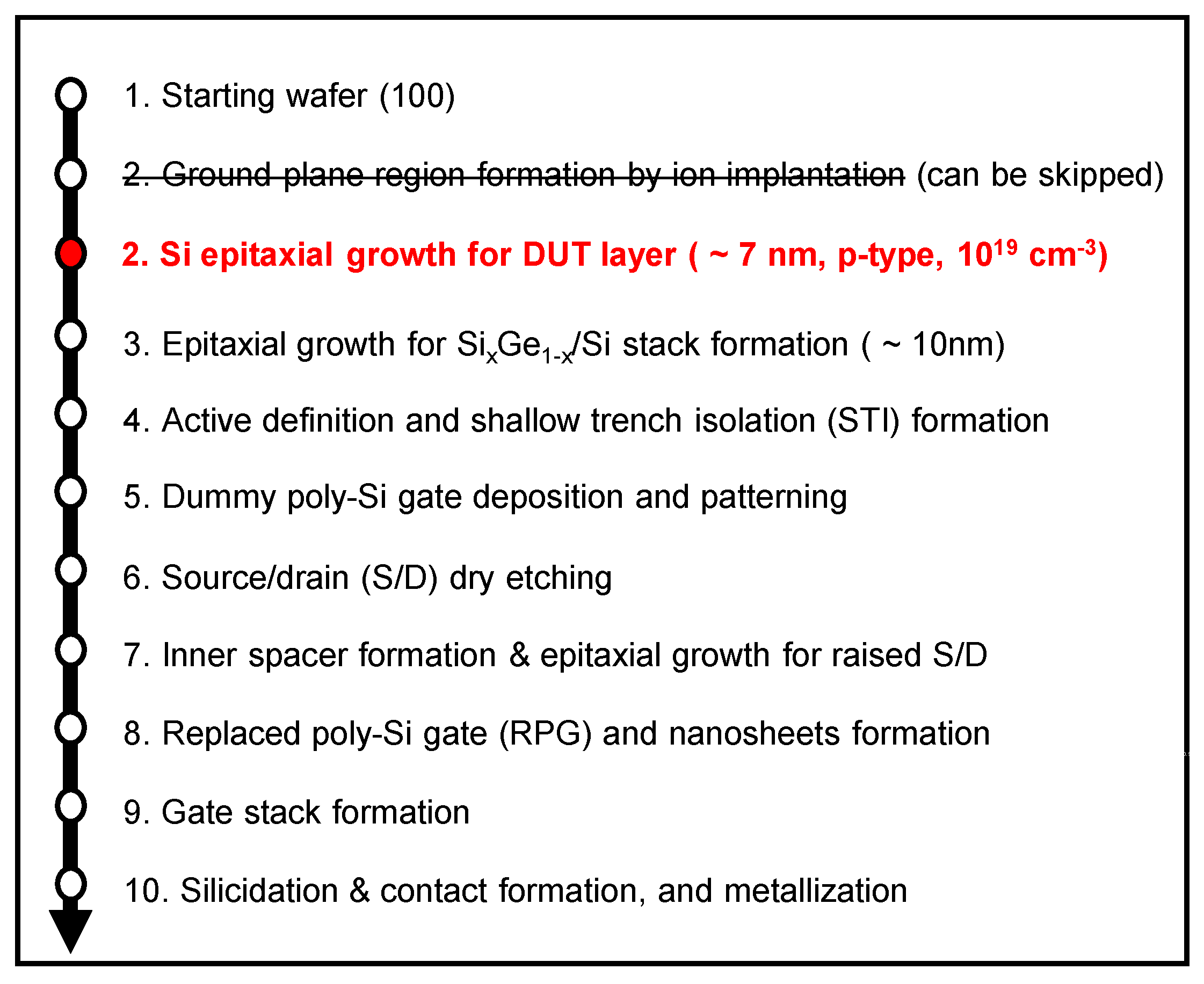
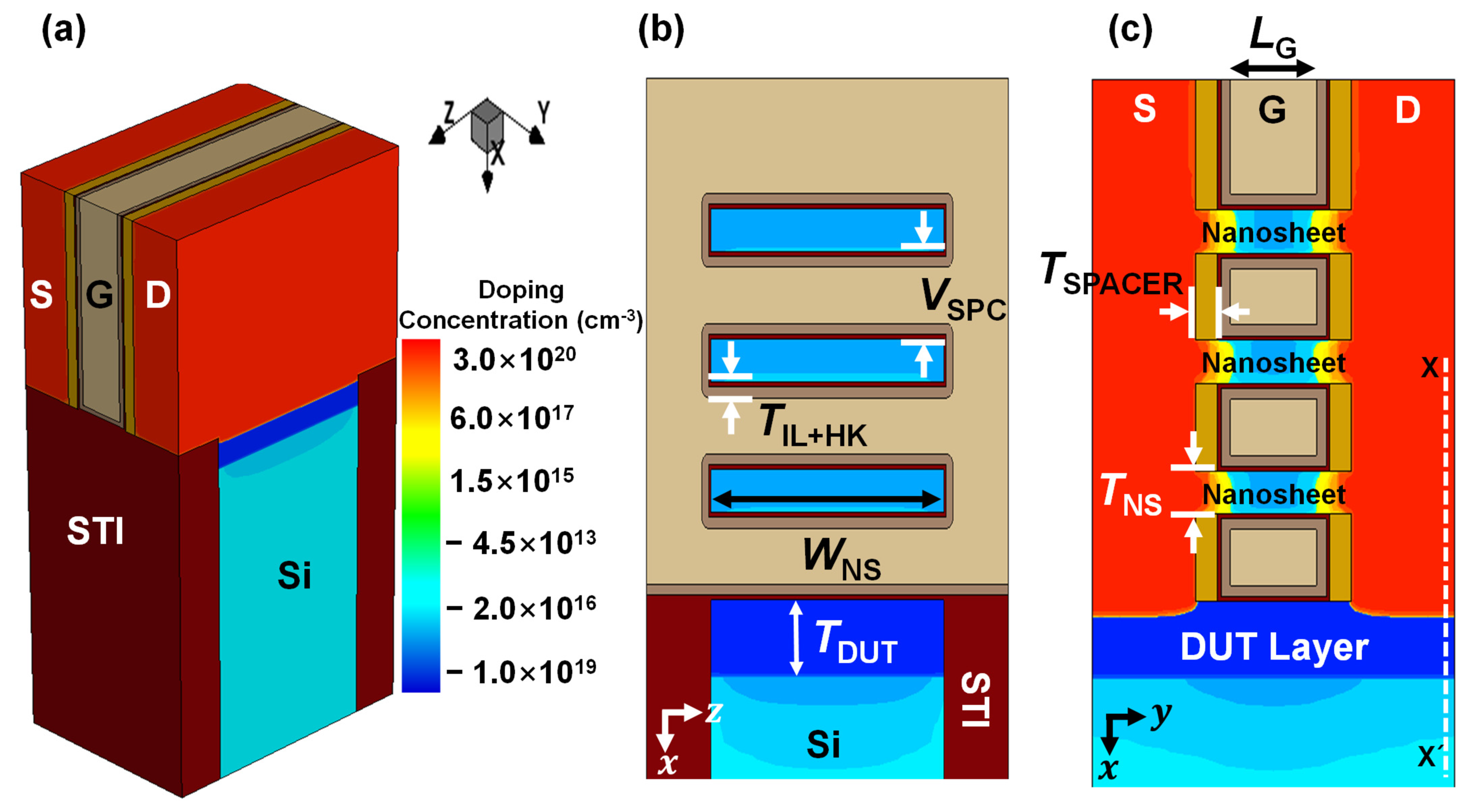
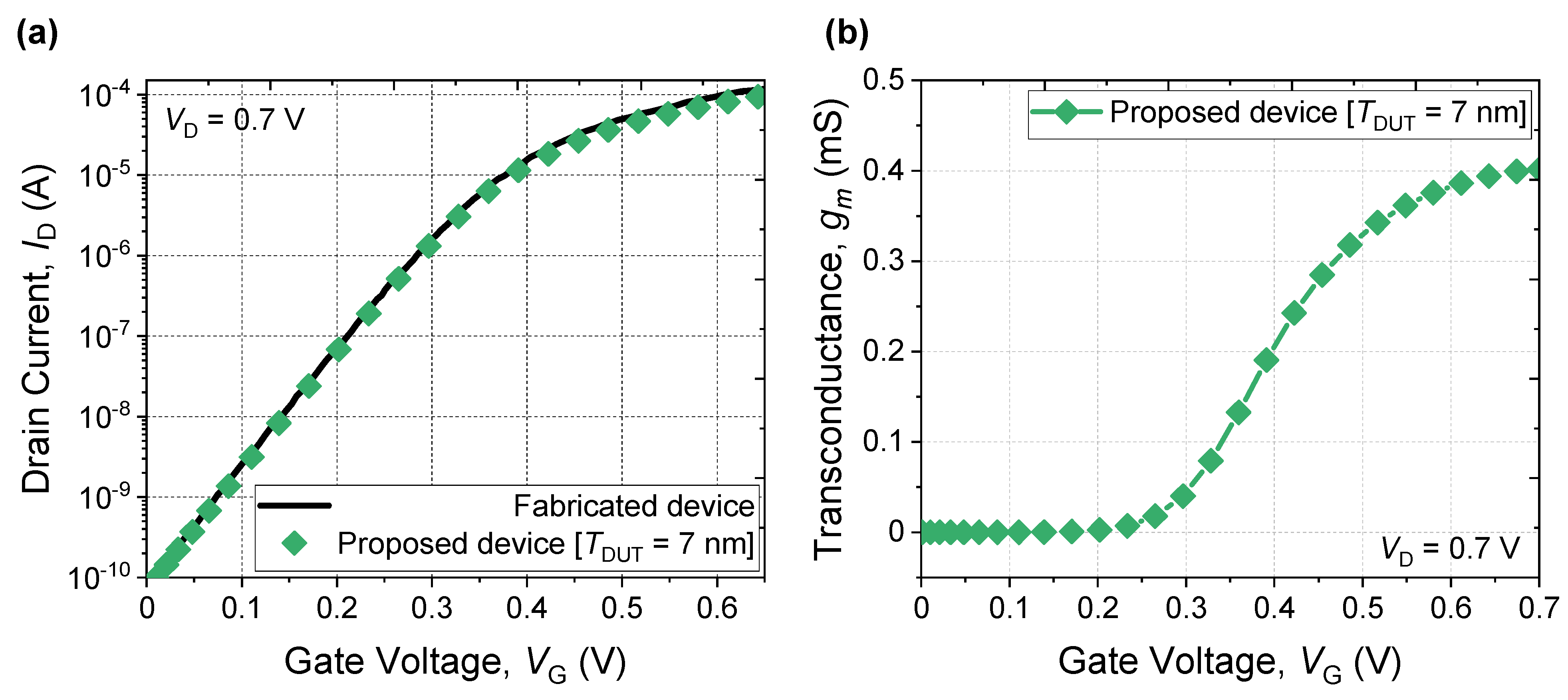
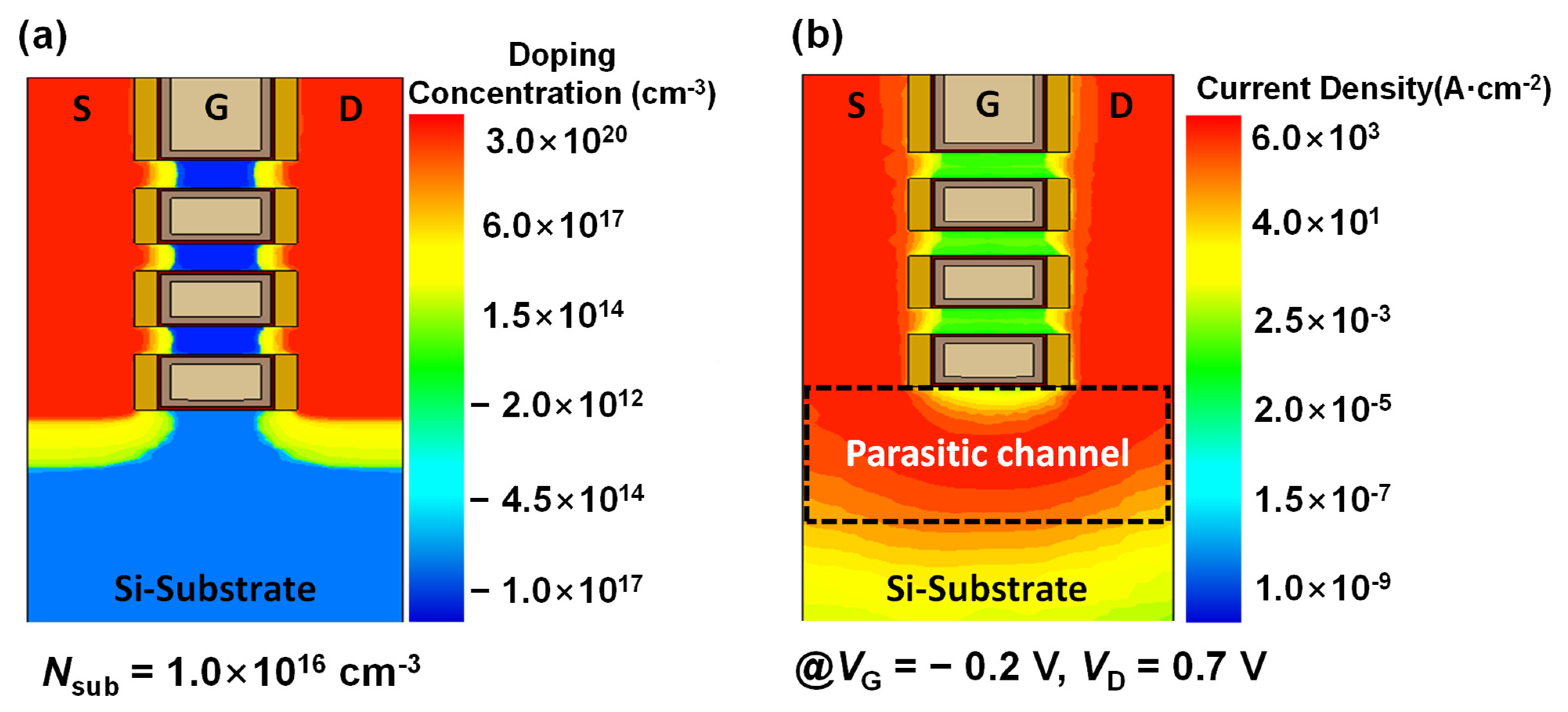
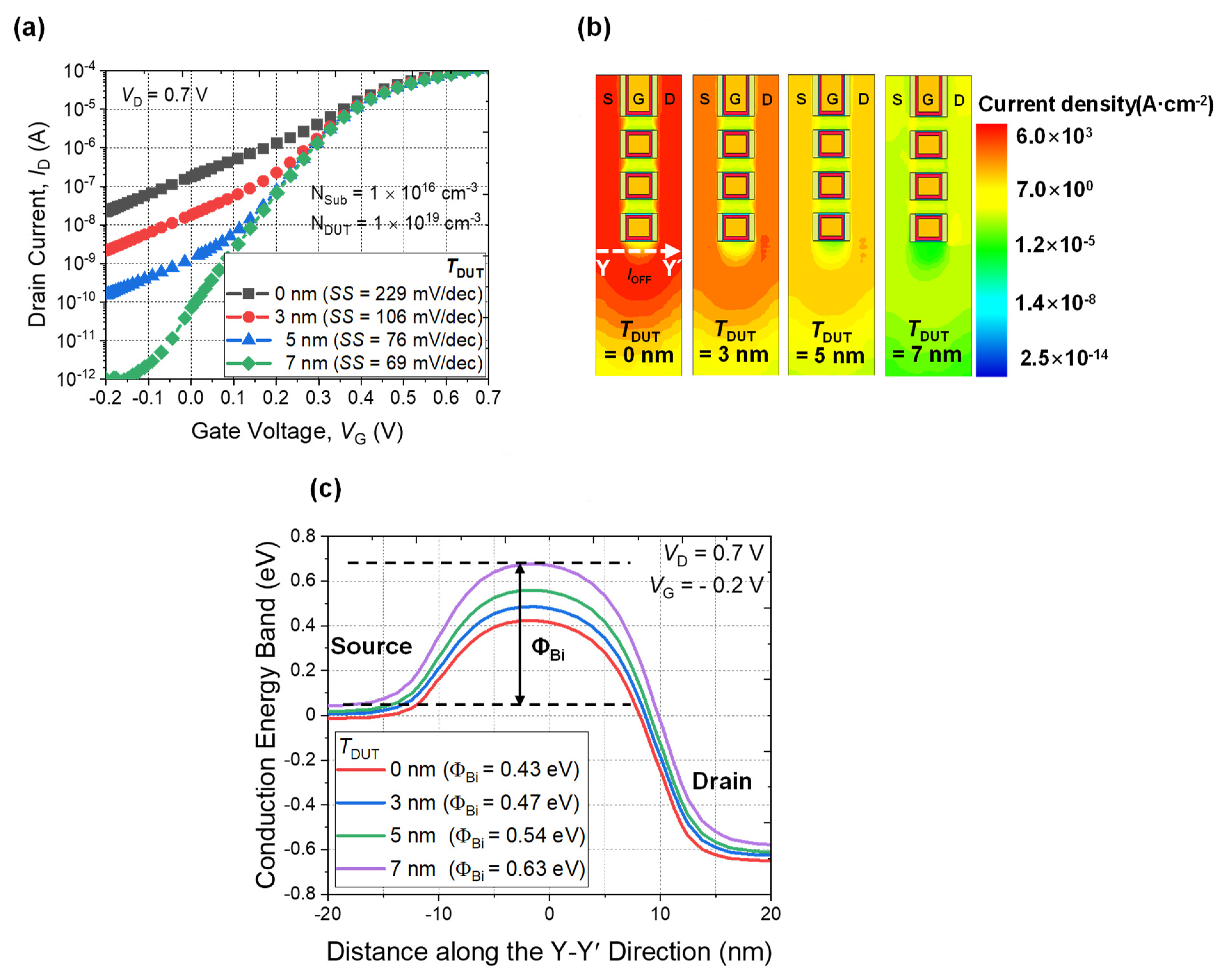
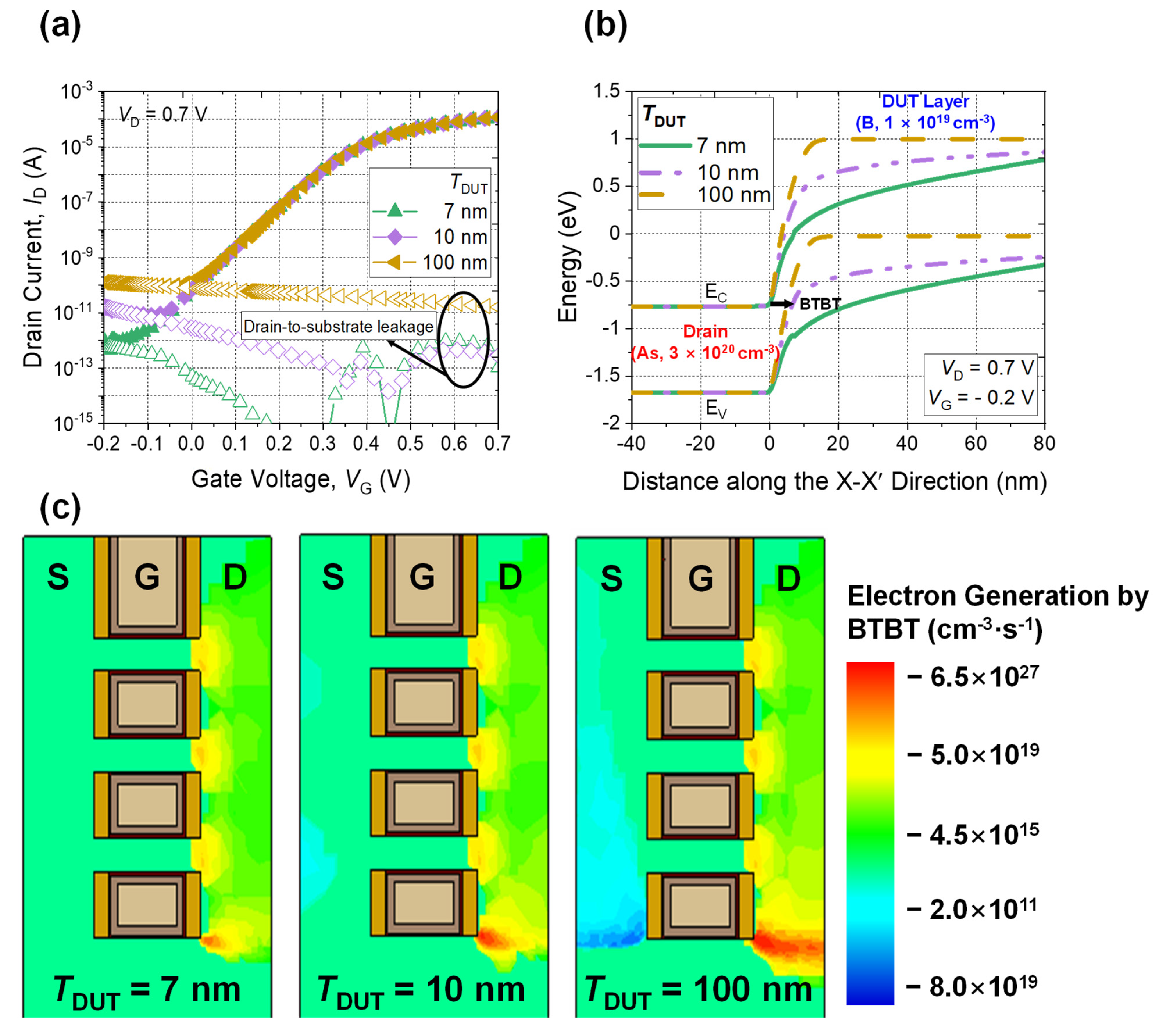

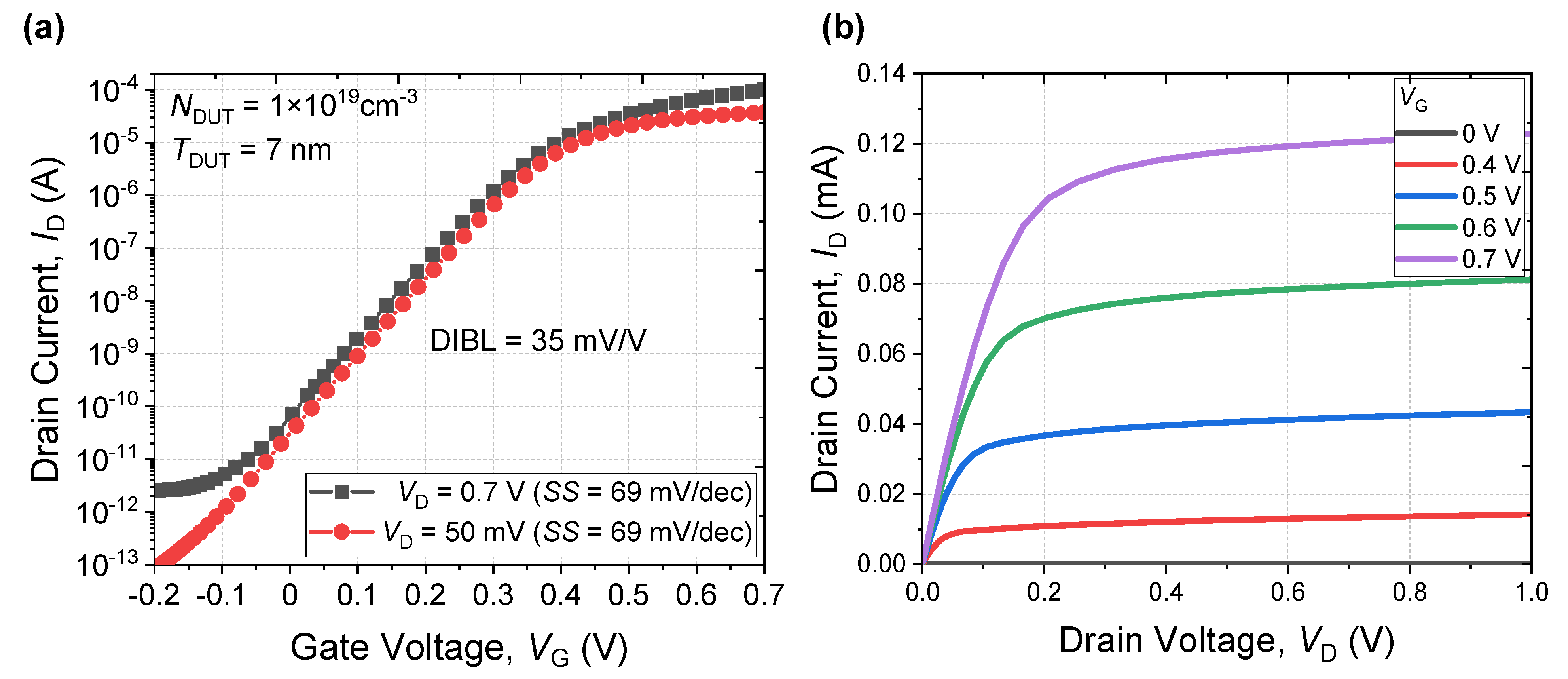
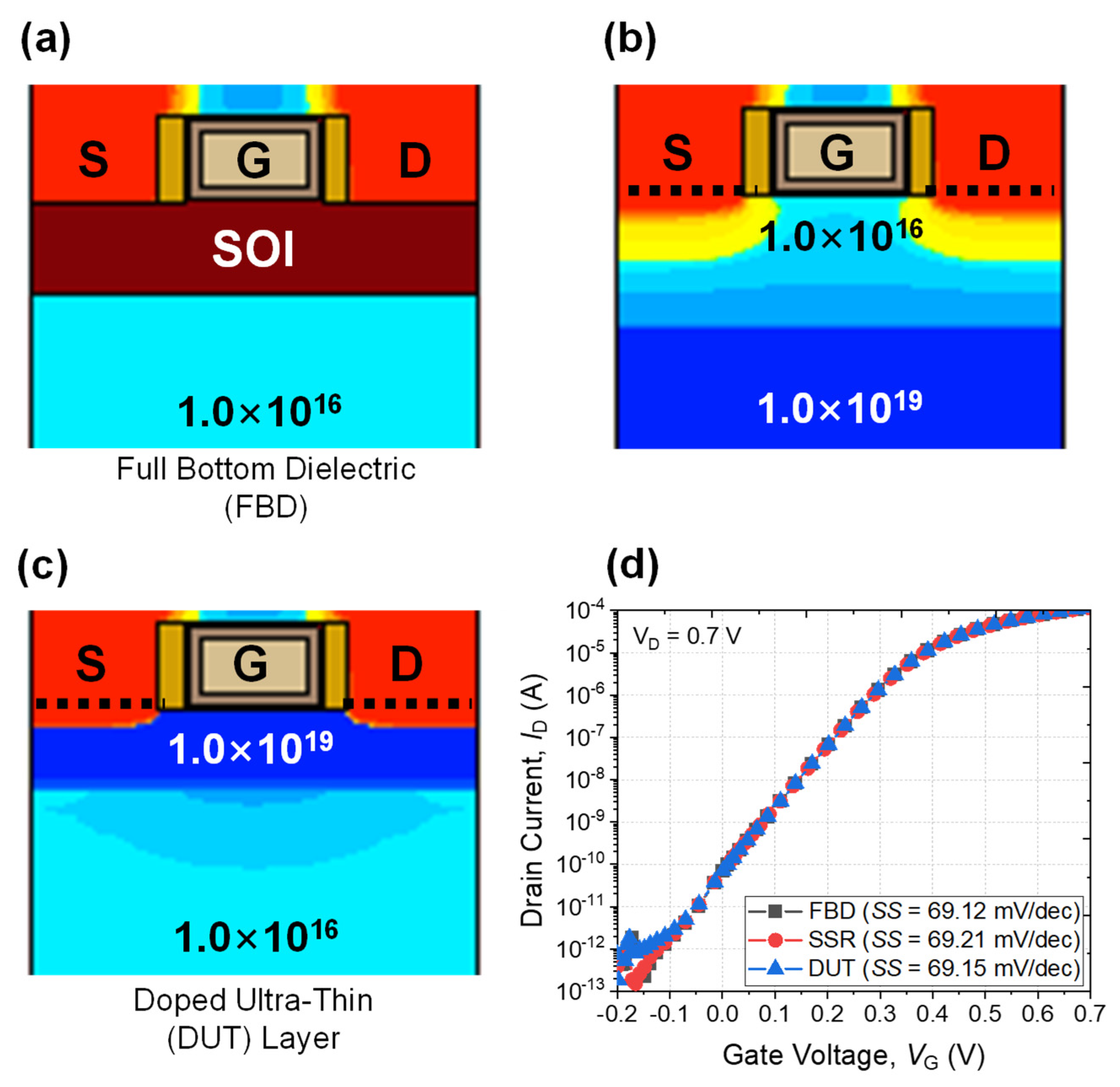
| Parameter | Value |
|---|---|
| Gate Length, LG | 12 nm |
| Nanosheet Width, WNS | 45 nm |
| Inner Spacer Thickness, TSPACER | 3 nm |
| Nanosheet-to-Nanosheet Vertical Space, VSPC | 10 nm |
| Nanosheet Thickness, TNS | 5 nm |
| Doped Ultra-Thin (DUT) Layer Thickness, TDUT | 5–100 nm |
| Doping Concentration of DUT Layer (NDUT) | 1019 cm−3 |
| Inter Layer SiO2 Thickness, TIL | 0.5 nm |
| High-k Gate Dielectric Thickness, THK | 1.28 nm |
| Contacted Poly-Si Pitch (CPP) | 44 nm |
| Planar FET [19] | FinFET [24] | NS FET [This Work] | |
|---|---|---|---|
| DIBL (mV/V) (VD = 50 mV and 0.7 V) | 208 | 89 | 35 |
| SS (mV/dec) | - | 72 | 69 |
| FBD | SSR | DUT | |
|---|---|---|---|
| VTH (0.7 V/50 mV) (mV) | 212/229 | 212/233 | 216/239 |
| SS (mV/dec) | 69 | 69 | 69 |
| ION (mA) at VG = 0.7 V, VD = 0.7 V | 0.117 | 0.117 | 0.102 |
| IOFF (pA) at VG = 0 V, VD = 0.7 V | 71.5 | 71.0 | 65.3 |
| DIBL (mV/V) (VD = 50 mV and 0.7 V) | 32 | 32 | 35 |
Publisher’s Note: MDPI stays neutral with regard to jurisdictional claims in published maps and institutional affiliations. |
© 2022 by the authors. Licensee MDPI, Basel, Switzerland. This article is an open access article distributed under the terms and conditions of the Creative Commons Attribution (CC BY) license (https://creativecommons.org/licenses/by/4.0/).
Share and Cite
Lee, K.-S.; Park, J.-Y. N-Type Nanosheet FETs without Ground Plane Region for Process Simplification. Micromachines 2022, 13, 432. https://doi.org/10.3390/mi13030432
Lee K-S, Park J-Y. N-Type Nanosheet FETs without Ground Plane Region for Process Simplification. Micromachines. 2022; 13(3):432. https://doi.org/10.3390/mi13030432
Chicago/Turabian StyleLee, Khwang-Sun, and Jun-Young Park. 2022. "N-Type Nanosheet FETs without Ground Plane Region for Process Simplification" Micromachines 13, no. 3: 432. https://doi.org/10.3390/mi13030432
APA StyleLee, K.-S., & Park, J.-Y. (2022). N-Type Nanosheet FETs without Ground Plane Region for Process Simplification. Micromachines, 13(3), 432. https://doi.org/10.3390/mi13030432






